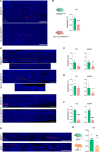Bone marrow sympathetic neuropathy is a hallmark of hematopoietic malignancies and it involves severe ultrastructural damage
- PMID: 40045344
- PMCID: PMC11884145
- DOI: 10.1186/s40164-025-00614-x
Bone marrow sympathetic neuropathy is a hallmark of hematopoietic malignancies and it involves severe ultrastructural damage
Abstract
The hematopoietic stem cell (HSC) niche in the bone marrow (BM) supports HSC function, fate and numbers [1]. Sympathetic fibres innervate the BM and are components of the hematopoietic stem and progenitor cell (HSPC) niche [2]. Neuropathy of the HSPC niche is present and essential for disease development in experimental models of JAK2V617F+ myeloproliferative neoplasms (MPN) and MLL-AF9+ acute myeloid leukemia (AML), and it is present in the BM of human MPN and AML patients [3-6]. Neuropathy contributes to mutant HSC expansion and represents an effective therapeutic target to block disease progression in JAK2V617F+ MPN mice [3]. The sympathomimetic agonist mirabegron restored nestin+ cells and reduced reticulin fibrosis in MPN patients [7]. Here, we show that neuropathy of the HSPC niche emerges in two additional experimental models of hematological disease including pre-leukemic myelopoiesis driven by NRASG12D and lymphoma/lymphoblastic leukemia driven by p53 deletion. Neuropathy involves severe ultrastructural damage in NRASG12D+ mice and AML patients as shown by electron microscopy. When further reinforced chemically, neuropathy has a profound impact on the experimental NRASG12D mouse model, promoting myeloid bias, reducing HSPC numbers and inducing changes in the stem cell microenvironment that include reduced numbers of mesenchymal stromal cells (MSC) and increased presence of morphologically abnormal blood vessels in BM. Together, BM neuropathy is a prevalent factor in hematopoietic malignancies that involves important degradation of sympathetic fibres and contributes to disease in a different manner depending on the driver mutation. This should be taken in consideration in the clinic, given that chemotherapy induces neuropathy of the HSC niche [8] and it is the most frequent first line treatment for AML, acute lymphoblastic leukemia and MPN patients.
Keywords: Hematological cancers; Peripheral nervous system; Stem cell niche; Sympathetic fibres; Transmission electron microscopy.
© 2025. The Author(s).
Conflict of interest statement
Declarations. Ethics approval and consent to participate: Animal experiments related to this work were approved by the Norwegian Food and Safety Authority under protocol numbers 7141, 7922, 7960, 8043, 8231, 8408, 9005, 21740 and 24735. Human studies were approved by the Regional Committee for Medical Research Ethics North Norway (REC North 2015/1082). Written informed consent was obtained in accordance with the Norwegian legislation and the Declaration of Helsinki. Participants received no compensation. Competing interests: The authors declare no competing interests.
Figures



References
-
- Mendez-Ferrer S, Lucas D, Battista M, Frenette PS. Haematopoietic stem cell release is regulated by circadian oscillations. Nature. 2008;452:442–7. - PubMed
-
- Arranz L, Sanchez-Aguilera A, Martin-Perez D, Isern J, Langa X, Tzankov A, Lundberg P, Muntion S, Tzeng YS, Lai DM, et al. Neuropathy of haematopoietic stem cell niche is essential for myeloproliferative neoplasms. Nature. 2014;512:78–81. - PubMed
Publication types
Grants and funding
LinkOut - more resources
Full Text Sources
Research Materials
Miscellaneous

